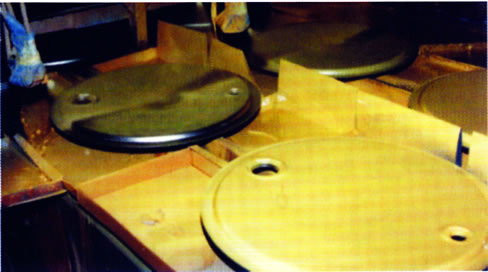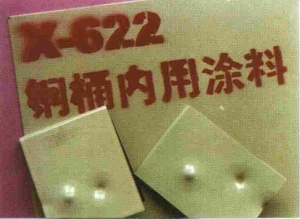|
1. Description of Epoxy Resin
Epoxy coating is one of optimal coatings for metals as well as the most universal interior coating used the earliest in China’s steel drum industry. Epoxy resin is one of the most important film-forming materials used by the epoxy coatings.
Epoxy resin generally refers to the macromolecular prepolymer of aliphatic, alicyclic or aromatic skeleton containing two or more epoxy bases. Due to the different materials and synthesis techniques adopted, the epoxy resin may have different performances and molecular weights, which can take liquid, ropy and solid forms. In general, it can be divided into glycidyl ether, glycidyl ester and glycidyl amine resins, alicyclic and linear alicyclic epoxy compounds as well as modified epoxy resin (such as element organosilicon, phosphorated epoxy resin and polyurethane epoxy resin) and bisphenol A resin.
Steel Drum with X-622 Interior Coating
2. Description of X-622 Steel Drum Interior Coating
Epoxy resin used to X-622 steel drum interior coating belongs to the bisphenol A DGEBPA resin made of such chloro-epoxy propane and bisphenol A through polymerization with sodium hydroxide.
As both chloro-epoxy propane and bisphenol A are bifunctional compounds, this type of epoxy resin is in linear structure, containing hydroxyl, ether and active epoxy groups. The high polarity as possessed by the hydroxyl and ether groups can produce high acting force on the epoxy resin and adjacent interface. Therefore, X-622 steel drum interior coating can develop high cohesive force on the steel drum surface. Moreover, the active epoxy group can endow the coat and the steel drum surface with high bonding force.
Bisphenol A DGEBPA epoxy resin used to X-622 steel drum interior coating adopts the molecular chain of carbon and ether bond structure with stable chemical property, which has high chemical, acid and alkali resistance. Furthermore, as the inward turning resistance imposed by the molecular chain on both ends of the epoxy group molecule is so limited, and the epoxy resin used to the X-622 steel drum interior coating has received low-viscidity softening treatment previously, the sound flexility can be ensured. This is especially appropriate for coating techniques (coating, roastering, solidify and crimping of drum body, bottom and top) adopted in steel drum industry.
With the help of active epoxy group as contained in epoxy resin, X-622 steel drum interior coating is available for cross linking curing with numerous organic compounds to acquire the property of solid 3D reticular structural film. The cross linking with phenolic resin subjecting to butanol etherification at high temperature can further enhance the mechanical property and chemical resistance of X-622 steel drum interior coating. The cross linking curing reaction at high temperature discharges only 30% water, and will not produce any other byproduct. The minimum shrinkage as well as the solid and compact reticular structural film formed through the cross linking curing reaction can further enhance the adhesion, mechanical property as well as corrosion and chemical resistances of the coat.

Drum Cover with X-622 Coating
3. Features of X-622 Steel Drum Interior Coating
3.1 Owing to the low-viscidity softening treatment based on the “X-6 Technique”, the Bisphenol A glycidol ether (DGEBPA) epoxy resin used to X-622 steel drum interior coating has the minimum viscidity when the resin content remains the same. This is favorable for the one-off formation of thicker coating film as well as the application of “coating-baking” coating technique to the steel drum.
3.2 X-622 steel drum interior coating contains no softening agent. The softening agent is expected to ensure the flexility of the coating through widening the molecular clearance of the epoxy resin. However, the widened molecular clearance of epoxy resin may affect the anticorrosive property of the coating film during the softening process. As the epoxy resin used to X-622 steel drum has received low-viscidity softening treatment previously, it can ensure the free crimping of the steel drum even if no softening agent is added.
3.3 X-622 steel drum interior coating contains no auxiliary agents, such as adhesion promotor, leveling agent and antifoaming agent. As these auxiliary agents may somewhat affect the cross linking between the epoxy resin and the phenolic resin subjecting to butanol etherification while improving the performance of epoxy coatings, it is apt to cause defects to the 3 D reticular structural film. Consequently, it may affect the anticorrosive resistance of the coating.
3.4 X-622 steel drum interior coating completely takes the imported rutile titanium dioxide powder subjecting to particle surface treatment as pigment and filler, which is free of any cheap pigment and filler, such as talcum powder, calcium carbonate, barium sulfate and lithopone. Therefore, it can ensure the lucent and smooth coat finish as well as the excellent anticorrosive resistance.
3.5 As the polar hydroxyl group and ether bond contained in the bisphenol A glycidol ether (DGEBPA) epoxy resin used to X-622 steel drum interior coating can form the chemical bond through the reaction with metallic surface dissociative bond. It is an ideal coating of the best adhesion for steel drums.
3.6 As enhanced structural stability of the C/C and ether bond in the molecular chain following the cross linking and curing of X-622 steel drum interior coating can further improve the compactness of the film structure, it can also enhance the chemical corrosion (especially alkali resistance) as well as compound medium corrosion resistance of the coating.
3.7 The 3D solid structure formed through the curing reaction and film formation can ensure the high mechanical strength, stability and insulation property of X-622 steel drum interior coating.
3.8 As the inherent compactness and stability of X-622 steel drum interior coating following curing reaction and film formation may affect the adhesion of other resin paints, it is not applicable to apply other paints on the coating. If inside of the steel drum is to be provided with two layers of coats, the primer coat must be roasted at low temperature in short possible time.
3.9 As bisphenol A glycidol ether epoxy resin has such common faults as poor weathering resistance and pulverization under the ultraviolet illumination, X-622 steel drum interior coating is not available for external use.
3.10 As per Hygienic Standard for Epoxy Phenolic Resin Coating for the Internal Lacquer of Food Cans (GB4805-1994), free phenol and formaldehyde as contained in the baked epoxy phenolic resin coating should not be lower than 0.1mg/g. However, according to the inspection by Shanghai Municipal Center for Disease Control & Prevention, X-622 coating actually contains no free phenol and formaldehyde. Furthermore, other safety and sanitation indices, such as residue on evaporation and consumption of potassium permanganate also excel that specified by the national standard by more than 3 times. This is the reason why X-622 coating can pass the SGS International Certification, and is up to FDA Standard for Food and Drug Coatings .
Actually, the epoxy resin subjecting to the thorough curing reaction with phenolic resin following butanol etherification is basically nontoxic. Through the oral taking by the adult rat, the LD50 of the coating subjecting to thorough cross linking and curing reaction is over 15, 000 mg / kg. Furthermore, as proved through Ames test, the coating is in negative, and will not cause malformation, somatic mutation and cancerization. Therefore, this type of coating is applicable to the internal coating for steel drums of food grade. Nevertheless, this is only limited to thorough curing. It is natural that any coating not thoroughly cured is toxic, and is unable to bring its properties into display. On the contrary, the high curing temperature may produce other toxic gases, such as propylene and chloromethane in addition to previous damages to its properties incurred by the burnt coating. Therefore, it is appropriate to bake this type of coating at a temperature of 182 ℃ for 45 minutes. If there is no drying tunnel available for 40-minute baking, it would be applicable to proceed with the curing at a temperature of 225℃ for approximately 10 minutes.
The right map is 1mm winding. 50kg .cm against rush and delimit O level after the X-622 epoxy coating test a flat.(This is colour coating after dry it is a without colour transparency coating)

|

